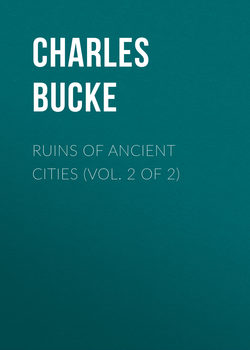Читать книгу Ruins of Ancient Cities (Vol. 2 of 2) - Charles Bucke - Страница 9
NO. IX. – PUTEOLI
ОглавлениеA maritime city of Campania, between Baiæ and Naples. It was founded by a colony from Cumæ. It was, in the first instance, called Dicæarchia, (“Just Power45,”) and afterwards Puteoli, from the great number of wells that were in the neighbourhood.
It was delightfully situated on a point projecting into the sea, nearly in the centre of the bay of Puzzuoli. It was the sea-port of the inhabitants of Cannæ; and a rendezvous for merchants from Greece, Sicily, and all parts of Italy. The attractions of the town, also, on account of its hot baths and mineral waters, allured the more opulent citizens of Rome to its vicinity.
In the square of the town stands a beautiful marble pedestal, covered with bas-reliefs, representing the fourteen towns of Asia Minor, destroyed by an earthquake, and rebuilt by Tiberius. It supported a statue of that emperor, erected by the same cities as a monument of gratitude. The cathedral stands on the ruins of a temple, and is built chiefly of ancient materials.
A temple of Serapis offers many subjects of observation. Half of its buildings, however, are still buried under the earth thrown upon it by volcanic commotions, or accumulated by the windings of the hill. The inclosure is square, environed by buildings for priests, and baths for votaries; in the centre remains a circular platform, with four flights of steps up to it; vases for fire, a central altar, rings for victims, and other appendages of sacrifice, entire and not displaced; but the columns that held its roof have been removed to the new palace of Caserta. The temple itself was not discovered till A. D. 1750, on the removal of some rubbish and bushes, which had, till then, partly concealed it from observation.
Behind this place of worship, stand three pillars without capitals, part of the pronaos of a large temple. These are of Cipoline marble, and at the middle of their height, are full of holes eaten in them by the file-fish46.
In the neighbourhood of Puteoli are many relics of ancient grandeur, of which none deserves more attention than the Campanian Way, paved with lava, and lined on each side with venerable tombs, the repositories of the dead, which are richly adorned with stucco in the inside. This road was made in the most solid, expensive manner, by order of Domitian, and is frequently the subject of encomium in the poems of Statius.
One of the most striking monuments of the city is the remains of the mole that formed the ancient part. Several of its piers still stand unbroken; they are sunk in the water, and once supported arches (to the number of twenty-five,) part of which remain above the water.
At the end of this mole began the bridge of Caligula, which extended across part of the bay to Baiæ, no less than half a mile in length in a straight line. This structure has long since been swept away.
On the hill behind the town are the remains of an amphitheatre, called, after that at Rome, the Coliseum. It was of considerable magnitude. The gates, and a large portion of the vault and under apartments, remain. One of these apartments, or rather dungeons, in which St. Januarius, the patron saint of Naples, was confined, is now turned into a damp and gloomy chapel; the arena is a garden; vines, fig-trees, and pomegranates, have gradually crept up the circumference, and now cover the slope, and run over the ruin47.
It is easy to guess what the animation and splendour of Puteoli must have been, at the time when the riches of the East were poured into its bosom; and when its climate, wit, and beauty, allured the most opulent Romans to its vicinity.
Cicero had a marine villa here, called Puteolanum. Pliny relates that it was on the shore, and adorned with a portico, which seems to have been remarkable for its beauty. He adds that Cicero erected here a monument, and that, shortly after his death, a fountain of warm water, very wholesome for the eyes, burst forth, and gave occasion to an epigram, which the philosopher quotes with applause48. The portico is fallen, the groves are withered, the fountain dried up, and not a vestige of the retreat left behind to mark its situation. The verses remain, and perpetuate the glory of the orator, the fame of the fountain, the beauty of the villa, and what is more honourable than all united, the gratitude of Cicero’s freed-man, Tullius.
St. Paul landed here in his way from Rhegium to Rome; and found Christians even in that early age. In the museum of Portici is a picture presenting a view of ancient Puteoli, supposed to have been painted before St. Paul landed there. “The picture,” says Mr. Williams, “is of course very different from the present state of the city; but still a likeness may be traced, if we keep in view the site of the various temples, and other objects, the foundations of which are still visible.”
On the sea shore, near Puzzuoli, are also found seals, coins, cornelians, and agates; bearing impressions of corn, grapes, and vine-branches, ants, eagles, and other animals. These are thrown up by the waves, after violent storms; and commemorate the magnificence of a city, now forming part of the Mediterranean bed49.
45
“This name indicates,” says Mr. Swinburne, “that they pursued, or wished to be thought to pursue, a line of conduct in commercial transactions, which it would be happy for mankind, all maritime powers would adopt.”
46
Pholas dactylus.
47
Eustace.
48
Plin. xxx. c. 3.
49
Pliny; Swinburne; Eustace; Wilkinson.
